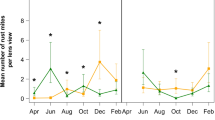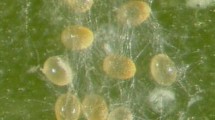Abstract
The results of investigations onTyphlodromus italicus Chant in some peach orchards in the Verona district, where the predator is wide-spread, are described.
Both field and laboratory studies have shown thatT. italicus grows rapidly (egg to adult 6 days at 25°C.) and has a long reproductive period, especially when prey is available. It speedily recovers in number and has a high prey-searching capacity. It is fast-moving, and its distribution over the tree corresponds to that of the phytophagous mites. It can live and reproduce on the tree in the absence of prey. A density of 50–60T. italicus/100 leaves is reached in August.
FemaleT. italicus are found on leaves till November feeding whenever prey is available, and wintering in a mated condition in bark crevices. Many enter diapause in late autumn. Overwinter mortality is high.
These characteristics enableT. italicus to play a very significant role in the control of peach mites and in orchards, which are unsprayed, it keeps their populations at a low density from spring to autumn.
Résumé
Les études en laboratoire et en verger ont montré queTyphlodromus italicus se développe en 6 jours de l'œuf à l'adulte à 25°C. II a une longue période de reproduction surtout si des proies sont disponibles, il se multiplie rapidement, a une excellente capacité de recherche des proies et sa distribution dans l'arbre correspond à celle des acariens phytophages. Il peut vivre et se reproduire dans les arbres en l'absence de proies. En août on observe une densité de 50 à 60T. italicus pour 100 feuilles. Des femelles deT. italicus sont rencontrées sur les feuilles jusqu'en novembre, elles s'alimentent chaque fois qu'une proie se présente et hivernent à l'état mûr dans les crevasses des écorces. Beaucoup d'entre elles entrent en diapause à la fin de l'automne. Il y a une forte mortalité hivernale. Ces caractéristiques permettent àT. italicus de jouer un rôle très significatif dans la lutte contre les acariens du pêcher: dans les vergers non traités il maintient leurs populations à de faibles densités du printemps à l'automme.
Similar content being viewed by others
References
Bohm, H. — 1960. Untersuchungen über Spinnmilben in Österreich. —Pflanzenschützber., 25, 23–46.
Chant, D. A. — 1959. Phytoseiid mites [Acarina: Phytoseiidae]. Part I: Bionomics of seven species in South-eastern England; Part II: A taxonomic review of the family Phytoseiidae, with description of thirty-eight species. —Can. Entomol., 91, Suppl. 12, 166 pp.
Dosse, G. — 1957. Über einige Faktoren die den Aufbau einerTyphlodromus Population bestimmen [Acarina: Phytoseiidae]. —Anz. Schädlingk., 30, 23–25.
Ivancich gambaro, P. — 1975. L'importanza delTyphlodromus italicus Chant [Acarina: Phytoseiidae] e delloStethorus punctillum Weise [Col. Coccinellidae] sulla dinamica delle popolazioni degli acari fitofagi del Pesco. —Boll. Lab. Zool. Gen. Agr. Portici, (in corso di pubbl.).
Mc Murtry, J. A. &Scriven, G. T. — 1964. Biology of the predaceous miteTyphlodromus rickeri [Acarina: Phytoseiidae]. —Ann. Entomol. Soc. Am., 57, 362–367.
Putman, W. L. — 1962. Life history and behavior of predaceous miteTyphlodromus (T.) caudiglans Schuster [Acarina: Phytoseiidae] in Ontario, with notes on the prey of related species. —Can. Entomol., 94, 163–177.
Putman, W. L. &Herne, D. C. — 1964. Relations betweenTyphlodromus caudiglans Schuster [Acarina: Phytoseiidae] and phytophagous mites in Ontario peach orchards. —Can Entomol., 96, 925–43.
— — 1966. The role of predators and other biotic factors in regulating the population density of phytophagous mites in Ontario peach orchards. —Can. Entomol., 98, 808–820.
Sapovnikova, F. D. — 1964. Relations between seasonal cycle of a spider mite and its predator. —Bio. Met. Bor'bys Vredit. Sel'skhoz. Norvosibirsk, 182–185 (in Russian).
— — 1964. The photo-periodic reactions of the miteTyphlodromus (Amblyseius) similis (C. L. Koch) [Acarina: Phytoseiidae]. —Zool. Zh., 43, 1140–1144 (in Russian).
Author information
Authors and Affiliations
Additional information
Studies of the Working Group of the C.N.R. on the integrated control against animal enemies of plants: n.CVIII.
Rights and permissions
About this article
Cite this article
Ivancich-Gambaro, P. Observations on the biology and behaviour of the predaceous miteTyphlodromus italicus [Acarina: Phytoseiidae] in peach orchards. Entomophaga 20, 171–177 (1975). https://doi.org/10.1007/BF02371657
Issue Date:
DOI: https://doi.org/10.1007/BF02371657




